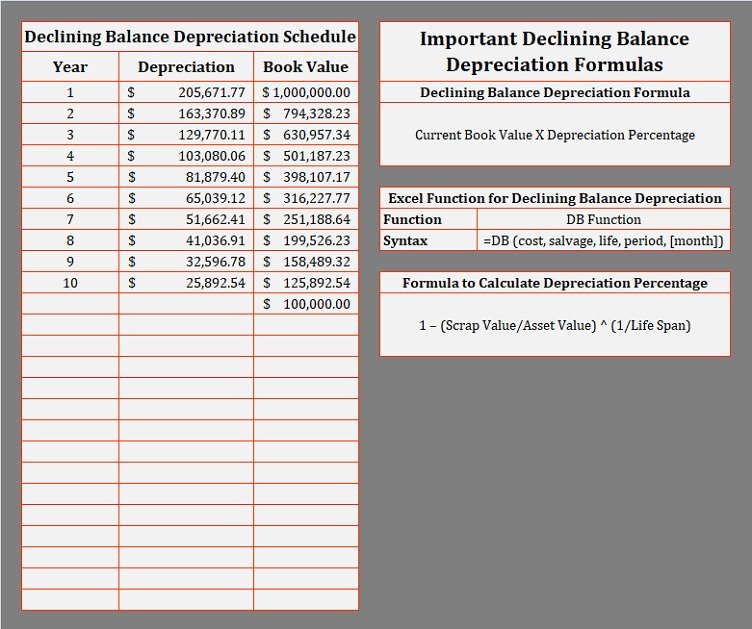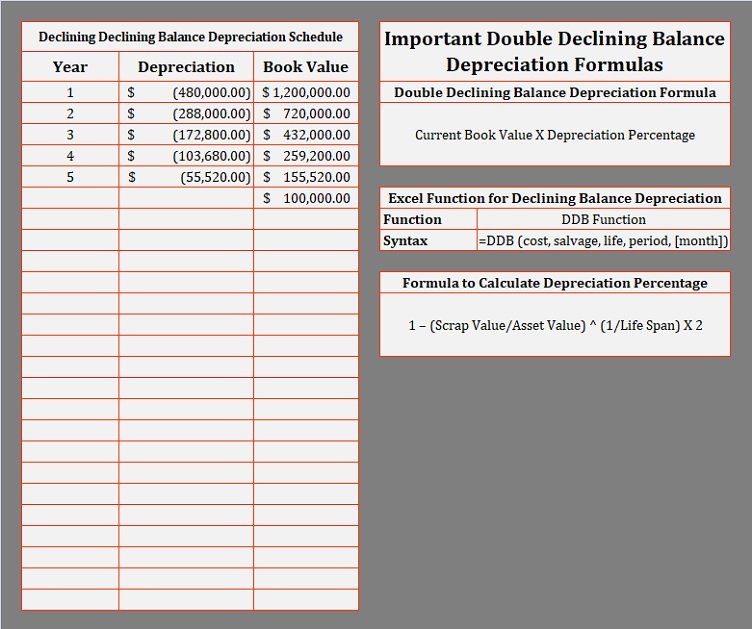Declining Balance Depreciation Calculator in Excel, OpenOffice Calc & Google Sheet to depreciate your tangible asset on decreasing book value.
Moreover, you can calculate depreciation by the declining balance method as well as the double-declining balance method with this template.
Additionally, this template calculates the applicable depreciation percentage for the first year. It also provides the Depreciation Schedule for the life span of the asset.
Table of Contents
What is Declining Balance Depreciation?
Declining balance Depreciation is one of the accelerated depreciation methods in which the asset depreciates for a higher value in initial years as compared to later years.
Unlike the Straight Line Method, this method calculates deprecation on the reduced book value. Reduced book value is the value left after deducting the depreciation expense each year.
Hence, it is also known as the Reducing Balance Method.
Under this method, a constant depreciation rate applies to the book value of the asset at the end of each year. It calculates the depreciation based on asset value, salvage value, and life span.
Usually, businesses use this method for those assets that quickly lose their values or become obsolete. These assets include computers, cell phones, and other tech items where models/configuration changes frequently.
Formula To Calculate Declining Balance Depreciation
Declining Balance Depreciation = Current Book Value X Rate of Depreciation
Where:
Current Value = Book value of the asset at the end of the year.
Depreciation Rate = 100% / Life Span
What is Partial Depreciation?
Partial Depreciation means calculating proportionate depreciation on the asset depending date of purchase of the asset during the year.
Generally, assets are bought around the year and not always bought or sold at the beginning of the accounting year. Hence, we need to partially depreciate the asset for that particular year.
Use the formula given below to calculate partial depreciation.
Formula To Find Partial Depreciation
Partial Depreciation = (Annual Depreciation/ 12) X No of months
Where:
Annual Depreciation/12 gives you monthly depreciation of the asset and then multipliy it with no of months.
What is Double-Declining Balance Depreciation?
As the name suggests, the double-declining balance method is another type of accelerated depreciation where asset depreciates twice the rate of depreciation.
In simple terms, just multiply the rate of depreciation by two and use it as a depreciation rate.
Formula To Calculate Declining Balance Depreciation
Double Declining Balance Depreciation = Current Book Value X (Rate of Depreciation X 2)
Download Declining Balance Depreciation Calculator (Excel, OpenOffice Calc & Google Sheet)

We have created a simple and easy-to-use Declining Balance Depreciation Calculator with predefined formulas and functions. You just need to insert the cost, salvage value, and life span of the asset. That’s it.
The template will automatically calculate the depreciation and also prepare the depreciation for you. It calculates depreciation by both declining and double-declining methods.

Download your desired format and start using it.
Additionally, you can download other accounting templates like Straight-Line Depreciation Calculator, Accounts Payable Template, and Accounts Receivable Template, Profit and Loss Statement Template, Balance Sheet Template, etc.
Moreover, you can download other HR templates like Payroll Template With Attendance, Salary Slip Excel Template India, Simple Salary Sheet, and Employee Salary Sheet depending on the company requirement.
Feel free to contact us for the customization of this template as per your requirement. We also design new templates based on your needs. You can hire us for our services on Fiverr or directly contact us at info@msofficegeek.com.
How To Use Declining Balance Depreciation Calculator?
Declining Balance Depreciation Calculator of two sheets. Both sheets consist of 2 sections: the Data Input section and the Depreciation schedule.
Let us understand each section in detail.
Data Input Section

The data input section consists of the following heads:
Value of Asset
Additional Costs Of Set-up
Total Value
Life Span in Years (Estimated)
Estimated Scrap Value
Actual Scrap Value
Difference
Yearly Depreciation
Book Value at the end of Life Span
Depreciation Percentage
Enter the cost of the asset other additional costs incurred to make it functional. Leave it blank if there are no additional costs. This will calculate the total value of an asset for you.
Salvage value is the end value of an asset after the life span is over. Life span is the number of years an asset is expected to work.
The cell below this shows the difference between the estimated scrap value and the actual scrap value. It can either be below or above the estimated value. Thus, if the difference is 0 then the asset was sold for the estimated salvage price.
Suppose, it is sold for a value higher than the estimated scrap value then the business makes a profit. On the contrary, if the asset is sold for a price less than the estimated scrap price then it is a loss.
This is depreciation profit/loss, not actual profit/loss. It is the gain/loss against the estimated value of the asset. If it is profit, the last line will turn green and display the word “Profit”, “Loss” if it is a loss and turn red, and 0 if it is NIL.
Book value at the end of the year is either or as per the estimated scrap value. Moreover, it calculates the depreciation percentage using the following formula:
=1 – (Scrap value / Cost of Asset)^(1/Life Span)
Moreover, Excel consists of a DB function that can help you easily calculate declining balance depreciation. The syntax for this function is: =DB (cost, salvage, life, period, [month])
Declining Balance Depreciation Schedule

This section is auto-populated based on the data inserted in the above section. It displays the following:
Year
Depreciation
Book Value
The depreciation for each year is calculated using the following formula:
=IFERROR(IF(D16>$D$11, (D16*$H$9),””), “”)
Where D16 is the asset value, H9 is the depreciation rate and D11 is the scrap value.

Thus, in Double Declining Balance Depreciation, double the depreciation rate. This means, multiply it by 2.
The formula used here is:
=IFERROR(IF(D16=$D$11,””,MAX(-D16*$H$9*2,-(D16-$D$11))),””)
Furthermore, you can also use the DB function to calculate declining balance depreciation and DDB Function to calculate double declining balance depreciation.
Thus, the Book value is the value of the asset at the end of the year after deducting depreciation. The formula used here is:
=IFERROR(D16-C16,””)
Where D16 is the book value of the asset and C16 is the depreciation amount.
Functioning and delivery of both the template are similar except the depreciation formula.
Journal Entries for Declining Balance Method
There are different entries at different stages.
Journal Entry at Purchase of Asset
Asset Account – Debit
Cash, Bank, or Creditor Account – Credit
Journal Entry at Depreciation
Depreciation Account – Debit
Asset Account – Credit
Journal Entry at the end of the year
P&L Account – Debit
Depreciation Account – Credit
At the end of the accounting period, the Balance sheet reflects the Book Value of the asset which is decreased by the amount of depreciation every year.
Advantages of Declining Balance Method
- As the businesses can claim larger depreciation in this method, it reduces the taxable income and eventually decreasing the tax bill.
- Depreciation is calculated on book value rather than the cost of the asset as in the straight-line method.
- Moreover, this method balances the effect on the P&L account. Every year depreciation expense decreases and repair expense increases due to wear and tear of assets.
- Many governments accept this method for income tax purposes.
- This method is suitable for businesses that use large and complex technology with plant and heavy machinery.
Disadvantages of Declining Balance Method
- Puts a negative effect on the balance sheet in the initial years as due to heavy depreciation in the initial year’s profit decreases.
- Under this method, you cannot reduce the book value 0.
- Loss of interest is not taken into account for the money invested to purchase the asset.
Frequently Asked Questions
If you like this article, kindly share it on different social media platforms. So that your friends and colleagues can also benefit from the same. Sharing is Caring.
Moreover, send us your queries or suggestions in the comment section below. We will be more than happy to assist you.

